Notre-Dame de Paris Fire
15 Apr 2019
From Wikipedia, the free encyclopedia
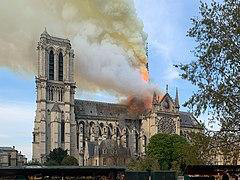
On 15 April 2019, just before 18:50 CEST, a fire broke out beneath the roof of Notre-Dame Cathedral, Paris. By the time it was extinguished 15 hours later, the building's spire and most of its roof had collapsed, and its interior, upper walls, and windows had been severely damaged; even more extensive damage to the interior was prevented by its stone vaulted ceiling, which largely contained the burning roof as it collapsed. Many works of art and other treasures were evacuated early in the emergency, but many others were damaged or destroyed. The cathedral's two pipe organs, and its three 13th-century rose windows, suffered little or no damage. Three people were injured.
Emmanuel Macron, the French President, promised that the cathedral would be restored, and launched a fundraising campaign which brought in pledges of €800 million within 24 hours. It has been estimated that restoration could require twenty years or more.
Background
The cathedral of Notre-Dame de Paris ("Our Lady of Paris"), a UNESCO World Heritage Site, was begun in the 12th century. Its walls and interior vaulted ceiling are of stone; its roof and spire are of wood (much of it 13th-century oak) sheathed in some 200 tones (220 short tons) of lead
to exclude water. The spire was rebuilt several times, most recently in the 19th century
In recent decades the cathedral's stonework has decayed alarmingly, primarily because of environmental pollution and the spire was extensively rotted because fissures in its lead sheathing were admitting water In 2014, the Ministry of Culture estimated needed renovations at €150 million, and in 2016 the Archdiocese of Paris launched an appeal to raise €100 million over the following five to ten years. At the time of the fire, the spire was undergoing renovations and scaffolding had been erected around much of the exterior.
-
Structural elements relevant to the fire
Left: timber-and-lead roof above stone ceiling; center: stone exterior walls; right: stone flying buttresses
Stone rib-vaulted ceiling
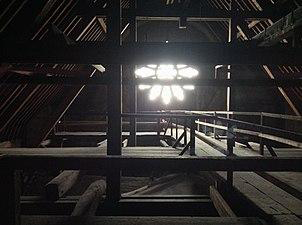
Timber roof framing; curved vault lies below walkway
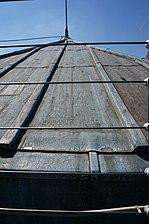
Lead roof sheathing
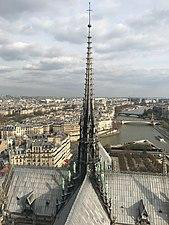
Roof and spire
Fire:

View from Quai de Montebello around 25 minutes into the fire; the spire is engulfed in flames
At about 18:20, guards first heard the fire alarm and began evacuating the cathedral but did not see a fire until 18:43, when either the alarm sounded again or a second alarm sounded. The cathedral was evacuated without incident within minutes
White smoke was seen rising from the roof The smoke turned black before flames appeared from the spire, then yellow.
Emergency response:
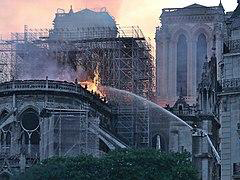
Firefighters using a deluge gun
Police quickly evacuated the Île de la Cité.
The Paris Fire Brigade had drilled regularly in preparation for any fire at the cathedral, including two on-site training exercises in 2018. They also assisted with the routine thrice-daily fire watch and operation of the alarm system.
Per common French fire-fighting practice, the fire was primarily fought from inside the structure. Attacking from the outside risked damaging the interior by deflecting flames and hot gases (at temperatures up to 800 °C or 1,500 °F) inwards. Twenty firefighters climbed the two towers' narrow spiral stairs but were eventually driven back by the heat.
Following emergency plans, water was supplied by boats pumping from the Seine. Deluge guns on the ground were used carefully; water streams were at lower-than-usual pressure to minimize damage to the cathedral and its contents.
Water dropped from the air was not used, as its impact could have contributed to structural damage and heated stone can crack if suddenly cooled. Helicopters were not used because of dangerous updrafts but drones were used for visual and thermal imaging, and robots were used for visual imaging and directing water streams.
Firefighters focused on saving the cathedral's towers. More than 400 firefighters were engaged another hundred worked to evacuate artefacts. Along with the high temperatures, molten lead falling from the roof also posed a hazard. While the lead cladding would initially have slowed the fire by excluding air, once it started melting, the wind would help spread the fire. A large oak beam isn't normally very flammable, but once smaller timbers are burning nearby, it can catch fire. One firefighter and two police officers were injured
Fire experts evaluated that the easier flammability of the oak timbers in the church had been underestimated by Benjamin Mouton, the architect who was previously responsible for the church. François Chatillon, an architect involved in restoring several French monuments, commented that it was already known the timbers were at a risk of catching fire which could not be stopped once it started
Most of the fire was extinguished by 23:30 CEST, and was considered completely extinguished after about twelve hours. The Paris fire chief said the bell towers and other structural elements would have likely failed had the fire burned for another 30 minutes.
Damage
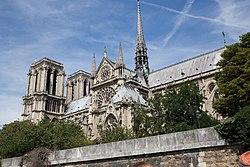
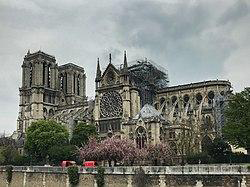
South facade before and after the fire, showing destruction of roof and spire
Within an hour of flames being seen, the roof and spire were fully involved and collapsed onto the stone vaulting that formed the ceiling of the cathedral's interior. A few sections of this vaulting collapsed allowing the burning roof to fall to the marble floor below; but most remained intact, greatly reducing damage to the cathedral's interior.[
Around 23:15 CEST, officials reported that the fire had weakened and that both towers were safe The primary structure, including both of the towers and one-third of the roof, remained standing. Inspectors later found some weaknesses in the surviving structure, and evacuated an adjacent row of apartment houses on the Rue du Cloître as a precaution.
All three of the church's 13th-century rose windows survived, although there was damage to some of the 19th-century windows.
Contents and decorative elements:
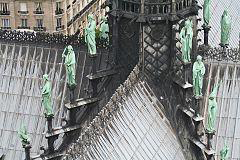
Statues of the Apostles had been removed for conservation days before the fire
The cathedral contained a large number of artworks, religious artefacts, and other irreplaceable treasures. These included a crown of thorns said to be the one Jesus wore prior to his crucifixion, a purported piece of the cross on which Jesus was crucified, the Tunic of St. Louis, a much-rebuilt pipe organ by Aristide Cavaillé-Coll, stained-glass windows, the Virgin of Paris statue of Mary and the baby Jesus, and bronze statues of the twelve Apostles Some contents were evacuated by a human chain of emergency workers and civil servants. Many valuables that were not removed also survived, but the state of many others remains unknown
Some artwork had been removed prior to the renovations, and most of the cathedral's sacred relics were held in the cathedral's sacristy a stone building that joins North Dame's south end The items held in the sacristy are thought to be safe. Some 180,000 bees that live in three beehives on the sacristy's roof also survived the fire.
Several pews were destroyed and the sculpted arches[were blackened by smoke, though the church's main cross and altar survived, along with the statues surrounding it.
Some paintings, apparently only smoke-damaged, are expected to be transported to the Louvre for restoration.
A number of statues, including those of the twelve Apostles at the base of the spire, had been removed in preparation for renovations. The rooster reliquary atop the spire was found, damaged but not destroyed, among the debris
Lead cames in some of the 19th-century stained-glass windows melted, but the three major rose windows, dating to the 12th and 13th centuries, were undamaged; one is unstable and may have to be dismantled for safekeeping.
The two pipe organs were not significantly damaged.
Some of the cathedral's bells were preserved,[further explanation needed] including the bourdon. The liturgical treasury of the cathedral and the "grands Mays" monumental tablets were evacuated during the fire.
Reactions:
Bystanders watch from Pont de la Tournelle
Numerous world religious leaders and governments extended condolences. French President Emmanuel Macron postponed a speech planned for that evening; instead he travelled to Notre Dame, where he gave a brief address
Through the night of the fire and into the next day, people gathered along the Seine to hold vigils and pray.
Investigation:
Within hours, the Paris prosecutor's office had opened an investigation led by the Paris Region Judicial Police. The investigation most strongly suspected accident but had not ruled anything out. On 16 April, the Paris prosecutor said that nothing his office had learned suggested a deliberate act
The fire has been compared to the similar 1992 Windsor Castle fire and the Uppark fire, among others, and has raised old questions about the safety of similar structures and the techniques used to restore them. Renovation works increase fire risks, and a police source reported they are looking into whether the renovation works had caused this incident In general, fires started during renovations of historic buildings can smolder for hours unseen before breaking out. It is likely that the Notre Dame fire remained small for a long time before abruptly expanding
Repairs to the lead roof required torch-welding lead sheets[24] which rested on dry, well-seasoned timber, much of it porous or powdery with age This is a particularly risky process for historic buildings. Restoration also involves electrical tools and wiring; normally, no electrical installations were allowed in the attics due to the extreme fire risk.
Of the firms working on the restoration a Europe Echafaudage team was the only one working there on the day of the fire. Marc Eskenazi, representative of its parent company Le Bras Frères, said no soldering or welding was being carried out. The scaffolding was receiving electrical supply for the elevators and lighting. Le Bras Frères said it had followed procedure and that none of its personnel were on-site when the fire broke out
The forensics team and the central laboratory were able to safely access parts of the church to investigate on 17 April. On 18 April, a judicial police official unofficially reported that investigators think a short circuit was the most likely causeA camera taking images in time-lapse format, that was installed by Europe Echafaudage, showed the smoke first started coming out from the base of the spire.
Reconstruction:
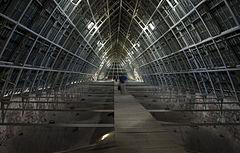
Chartres Cathedral was rebuilt with wrought iron trusses and copper sheeting after the 1836 fire
On the night of the fire, Macron announced that the cathedral, which is owned by the state, would be rebuilt, and launched an international fundraiser the next day The cathedral itself, as well as several other historical buildings in France, was not insured due to cost constraints, leaving the costs to rebuild to the state. The heritage conservation organization Foundation du Patrimoine estimated the damage in the hundreds of millions of Euros European art insurers stated the cost would be similar to ongoing renovations of the Palace of Westminster in London, which currently is estimated around €7 billion
This cost does not include damage to any of the artwork or artefacts within the cathedral; art insurers said any pieces on loan from other museums would have likely been insured, but the works owned by the cathedral would not have been insurable. While Macron hoped the cathedral could be restored in time for the 2024 Olympic Games in Paris, architects expect the work could take from twenty to forty years, as any new structure would need to balance restoring the look of the original building, using wood and stone sourced from the same regions used in the original construction, with the structural reinforcement required for preventing a similar disaster in the future.
The Île-de-France region announced it would allocate €10 million, and the City of Paris declared it would make €50 million available.
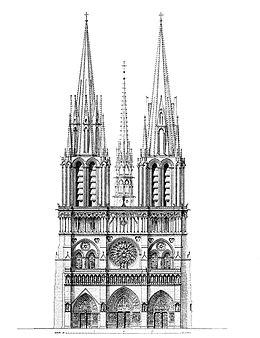
Unrealized rebuilding plan for Notre-Dame; only one spire was built
There is discussion of whether to rebuild the cathedral in modified formRebuilding the roof with titanium sheets and steel trusses has been suggested; other options include rebuilding in the original lead and wood, or a melding of restored old elements and newly-designed ones
Fundraising:
Twelve hours after the fire started, over €900 million had been pledged by a number of people, companies, and institutions for the cathedral's reconstruction.Major pledges include:
Arnault family & LVMH (€200M)[120]
Bettencourt family & L'Oréal (€200M)[121]
Pinault family & Artémis (€100M)[122]
Total SA (€100M)[123]
Paris city government (€50M)[124][125]
BNP Paribas SA (€20M)[126]
Decaux family & JCDecaux (€20M)[127]
AXA SA (€10M)[128]
Safra family (€10M)[129]
Bouygues family (€10M)[130]
De Lacharrière family & FIMALAC (€10M)[125]
Île-de-France (€10M)[125]
Société générale (€10M)[131]
BPCE (€10M)[131]
Kravis family ($10M)[125]










